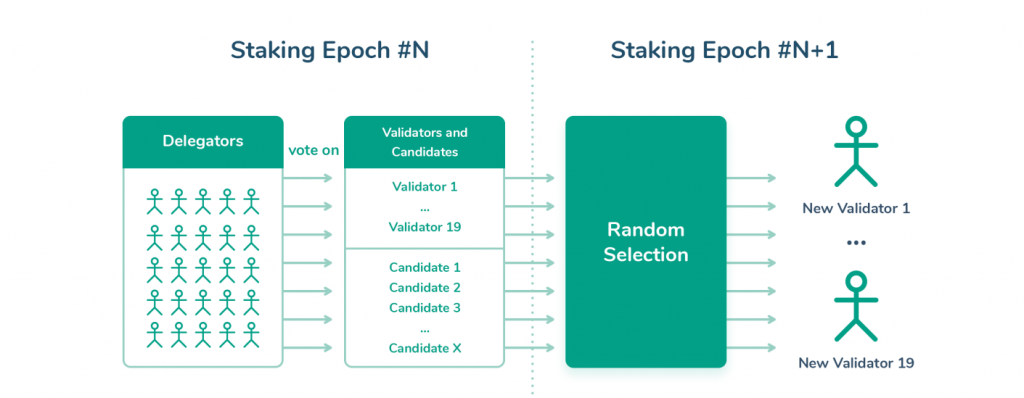Gnosis Merge: Transitioning to a POS future

The merge on Gnosis
On 8th December 2022, Gnosis Chain will undergo the Merge. The current execution layer will Merge with the parallelly running Beacon Chain, and the entire network will henceforth transition to a permissionless Proof-of-Stake (PoS) consensus mechanism from the current Proof-of-Authority (PoA) consensus. This blog will tell you all you need to know about the Gnosis Merge and what you need to do to prepare for it.
When will the merge happen?
Technically speaking, the Merge on Gnosis Chain has no fixed date or time. However, we can reasonably assume that the merge will happen sometime on 8th December 2022. This ambiguity arises due to how the Merge is set to be executed.
The ‘difficulty‘ of a particular block on a blockchain is a quantitative measure of how much computation power is required to generate that particular block. ‘Terminal total difficulty‘ (TTD), as the term suggests, is a measure of the total difficulty reached until that block. The Gnosis Chain core developers have set the terminal total difficulty to this value:
8626000000000000000000058750000000000000000000This value was proposed as a way to schedule the Merge during the week of 5th Dec 2022. As of now, the Gnosis Chain is predicted to reach this TTD sometime around 8th Dec.
How will users be affected?
The average user on the Gnosis Chain won’t be affected by the Merge in any way. No new coins will be minted, and no coins will be burned. The Gnosis token (GNO) will continue to be used for staking, and the xDai token will continue to serve as the native gas token.
For DApp developers on Gnosis Chain:
block.difficultywill be deprecated along the lines of the Ethereum merge. If your DApp uses the value as part of its algorithm, we recommend you make changes. You can read more on Gnosis Docs.
- Gnosis Chain previously had a mechanism to generate on-chain randomness with the help of the RandomAuRaCode smart contract. That mechanism will now be deprecated, and developers should find alternatives.
What does it mean for node operators?
Post-Merge, your Gnosis Chain node will need an execution layer client with a consensus layer client. Those two layers communicating with each other will form a full node.
As of the time of writing, only Nethermind has a Gnosis execution layer implementation ready for the Merge. As for the consensus clients, there are various options to choose from. You can read more about these in the Gnosis’ docs.
To run a node on your own, you would have to:
- Configure a server on your machine that remains online all the time to enable you to run a node seamlessly.
- Run an execution client, and configure it with a JSON Web Token (JWT) secret to allow it to communicate with the consensus client. On top of it, if you want to run an archive node, you would need at least 2TB of space on your disks, plus 2-6 weeks waiting for it to completely sync on your machine.
- You would then need to run a consensus client like Teku or Lighthouse, embedded with your execution client’s JWT key, to finally be able to run a full Gnosis Chain node.
With Chainstack however, you don’t have to worry about any of this. We have already:
- Set up fast and reliable servers ✅
- Configured Nethermind for an execution layer ✅
- Combined that with Lighthouse as a consensus layer to form a full node ✅
Follow these steps to sign up on Chainstack to deploy a node and find your credentials:
Go through this tutorial on our blog for all the details:

Parity’s AuRa(Authority Round) POA consensus model
Unlike Ethereum, Gnosis Chain doesn’t use the PoW consensus mechanism pre-Merge. It instead subscribes to an AuRA (Authority Round) Proof-of-Authority consensus model to add new blocks to the Gnosis Chain.
This is how it works:
- To start, Gnosis Chain currently divides its consensus operations into small time-frames of staking epochs. The default length of an epoch is 1 week, though it can be configured as required. A new set of validators is selected to add new blocks to the chain every time an epoch expires. Do note that a new set of validators can also include validators from the previous set, sometimes even leading to the formation of identical validator sets.
- It is important to understand what a delegator is and the difference between a validator and a delegator. An address can become a validator or a delegator by staking the respective minimum amounts of GNO tokens into the protocol. It is, however, only the validators that actually produce new blocks.
Delegators typically stake fewer tokens than validators, but they can ‘vote’ on a candidate by pooling in their stake with a particular candidate. Candidates with a good reputation will naturally attract more delegators.
- This combined candidate+validator stake is referred to as a candidate’s pool. The larger this pool, the higher the chances for a candidate to be included in the next validator set.
- Gnosis Chain implements a random number generator that selects a new validator set from an existing set of candidates, with a proportional preference to the size of a candidate pool.
- This new validator set produces new blocks for the entire epoch, while a new set of validators for the next is determined from the remaining candidates. The figure below will make the POSDAO validator selection process clearer.

Post-merge Gnosis consensus model
Gnosis Chain aims to closely mirror the Ethereum mainnet Merge that happened on 15th September 2022. Post-Merge, Gnosis Chain will switch to a permissionless PoS consensus mechanism.
This means a few changes to choosing validators for block production:
- No ‘delegators’ will be able to vote on validators to increase the total pool and, thereby, the chances of getting selected to produce the next blocks. Validators will now be chosen randomly, and a committee of 128 fellow validators will vote on the proposed block’s validity.
- The preference given to validators with big pools will be removed. Now each validator will have to stake a fixed amount of 1 GNO (32 mGNO) to participate in the validation process. You can, however, run multiple validators from a single node.
Gnosis Chain aims to mirror its’ Merge to that of Ethereum. There are, however, a few differences in the parameters between the two. You can have a look at the Gnosis Chain’s initial post-Merge parameters below.
| Variable | Value |
|---|---|
| Staking amount | 32 mGNO (equivalent to 1 GNO) |
| Block time | 5 seconds |
| Validator slots per epoch | 16 (with further reduction possible, N > 1 honest proposer/epoch as per V. Buterin) |
| Validators per slot | 128 (see more on minimum committee size) |
| Epoch time | 80 seconds |
| Slashing | Reductions to 16 mGNO, then removal |
| Clients | Prysm, Lighthouse |
| Custom Deposit Contract | mGNO deposit (ERC20 enabled) Upgradeable Claiming on accidental locks Custom network keys generation (deposit-cli) |
| Explorer | Modified beaconchain explorer 🔍 beacon.gnosischain.com |
| RPC | https://rpc-gbc.gnosischain.com |
| Launch MVP | 4096 validators 131,072 mGNO 83% APY |
| Security Goal Prior to Merge | 50K+ validators 1.6M+ mGNO 23% APY |
Explore all our services
- Discover how you can save thousands in infra costs every month with our unbeatable pricing on the most complete Web3 development platform.
- Input your workload and see how affordable Chainstack is compared to other RPC providers.
- Connect to Ethereum, Solana, BNB Smart Chain, Polygon, Arbitrum, Base, Optimism, Avalanche, TON, Ronin, zkSync Era, Starknet, Scroll, Aptos, Fantom, Cronos, Gnosis Chain, Klaytn, Moonbeam, Celo, Aurora, Oasis Sapphire, Polygon zkEVM, Bitcoin and Harmony mainnet or testnets through an interface designed to help you get the job done.
- To learn more about Chainstack, visit our Developer Portal or join our Discord server and Telegram group.
- Are you in need of testnet tokens? Request some from our faucets. Multi-chain faucet, Sepolia faucet, Holesky faucet, BNB faucet, zkSync faucet, Scroll faucet.
Have you already explored what you can achieve with Chainstack? Get started for free today.
 Ethereum
Ethereum Solana
Solana TON
TON Base
Base BNB Smart Chain
BNB Smart Chain Sui
Sui Unichain
Unichain Aptos
Aptos TRON
TRON Ronin
Ronin zkSync Era
zkSync Era Sonic
Sonic Polygon
Polygon Gnosis Chain
Gnosis Chain Scroll
Scroll Avalanche Subnets
Avalanche Subnets Polygon CDK
Polygon CDK Starknet Appchains
Starknet Appchains zkSync Hyperchains
zkSync Hyperchains



























